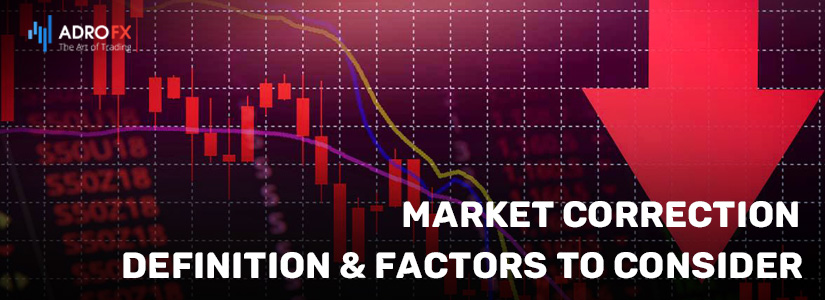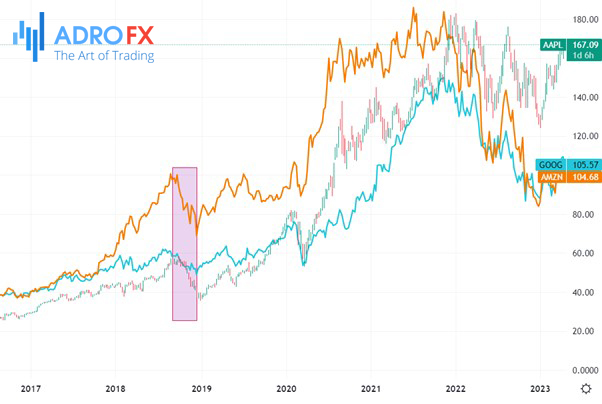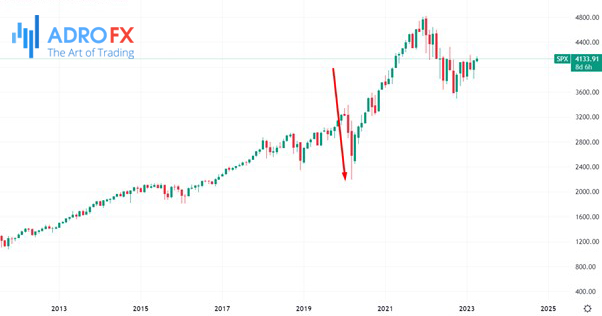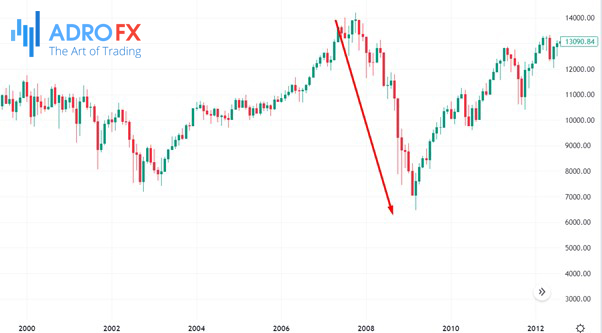Market Correction - Definition & Factors to Consider

Investing in the stock market can be a lucrative way to build wealth over time, but it's not without its risks. One of the biggest challenges investors face is how to preserve their capital when stocks are falling. When the market takes a downturn, it can be tempting to panic and sell off investments to avoid further losses. However, this approach can often lead to even greater losses and prevent investors from taking advantage of future market rebounds. In this article, we will learn more about a market correction, and explore strategies that can help investors preserve their capital during market downturns and emerge stronger when the market eventually recovers.
Market Correction: Definition
A correction is a 10-20% drop in the value of a financial instrument. It happens with shares of one company or whole indices that include hundreds of companies. On average, a price decline lasts four months, although it can take a day or a year. Causes can vary from a company's poor report to global geopolitical conflicts, but corrections can happen for no external reason.
Anything can correct stock prices, oil, platinum, grain, currencies, funds, an industry, or the entire market at once. For example, in 2018, the prices of more than 500 companies fell by 10%.

The correction is a frequent occurrence. On average, a 10-20% drop in the stock market happens once a year. Price declines of 20% or more occur once every six years; such a correction is called a collapse. One of the last collapses was caused by the pandemic, which dropped markets by 38% in a few days in March 2020.

Investors with a long-term strategy survive the correction the easiest: if they invest their funds for 5-10 years, they may not notice temporary price declines at all. Investors who use leverage and traders who benefit from short-term trading are hit hardest by the correction.
It is easy to see how a correction looks on the chart of any company. All you have to do is turn on the annual or five-year chart display and find periods when the value of the asset fell briefly. It is important to consider the drop in the stock price after the ex-dividend date - the so-called dividend gap. It has nothing to do with the correction.
What Causes a Correction?
A wide variety of events affect stock prices: speeches by company directors, investor reports, pandemics, laws, sanctions, hurricanes and floods, man-made disasters, and meetings of heads of state. These events can easily bring down the stock prices of even the most stable companies.
Humans are also the cause of the correction. People invest in stocks, which are inherently human, and the market sometimes corrects because of investor behavior. For example, if people like Elon Musk, they invest in his company more than it earns. Sooner or later the shares of such a "bloated" company will go down in price.
Sometimes investors try to keep up with the trend. For example, if a stock rises, people invest, thereby increasing the demand for security. And demand drives the price up. When the price gets high enough, some investors sell the stock to get a return. The correction begins and people who bought the stock last lose capital. So chasing the trend is not worth it.
Also, the correction can be seasonal. For example, in summer, on the eve of holidays or long weekends, investors participate in trading less frequently. There is less supply on the exchange, the liquidity of stocks decreases, and speculators try to benefit from this. During such periods, sharp price fluctuations occur, so the price of a stock may fall by 10-20%.
There is no sense to be afraid of a correction: sooner or later it will happen, because the market cannot grow indefinitely.
How Long Do Corrections Last?
From 1980 to 2018, there were 37 corrections in the US markets, with an average drawdown of 15.7%. Recovery took an average of four months. According to statistics, the investor invested $15,000 in January → lost $2,355 during the correction → by May, the portfolio will once again be $15,999. But sometimes things happen differently.
The more a stock loses value, the longer it takes to recover. For example, because of the financial crisis in 2008, US stocks plummeted by about 50%. The recovery of the stock market lasted 17 months, and that was with the active support of the US government and the Federal Reserve.

Financiers can only say for sure after the fact when exactly the correction begins. For example, the collapse of the markets in the example above began in October 2007 but was not officially announced until June 2008. Therefore, after the correction, the market may come to its senses immediately or it may take two years.
How to Predict a Correction
There is no reliable way to predict the start or end date of a correction, its duration, or the percentage by which the price of assets will change.
Some economists try to predict trends in the market. For example, Ralph Elliott came up with the theory that the market moves in waves, which are constantly repeating. You only need to know which wave the market is currently on - increasing or decreasing - and you can earn an income. If such theories always worked, no one would lose funds on corrections.
Therefore, we should remember that a correction will happen sooner or later, and if it has not been there for a long time, it is a reason to think twice.
Advantages and Disadvantages of Market Correction
Market corrections are a natural part of the market cycle, but they can have both advantages and disadvantages for investors.
Advantages of a market correction:
- Buying opportunities: Market corrections can provide an opportunity for investors to buy stocks at lower prices, which can lead to long-term gains when the market rebounds;
- Rebalancing: A market correction can prompt investors to rebalance their portfolios, selling overvalued stocks and buying undervalued ones, which can help optimize their long-term returns;
- Resetting expectations: Market corrections can help investors re-evaluate their expectations and risk tolerance, which can lead to more realistic investment goals and a more diversified portfolio.
Disadvantages of a market correction:
- Losses: Market corrections can cause significant losses for investors who are heavily invested in the market, especially if they sell off their investments in a panic;
- Economic impact: Market corrections can have a negative impact on the broader economy, causing job losses and lower consumer spending;
- Psychological effects: Market corrections can cause fear and uncertainty among investors, leading to emotional decision-making and potentially harmful actions.
What Should You Do During a Correction?
Correction can make an investor richer or poorer or have no effect at all. Everything depends on the actions of an investor. It is impossible to say for sure what to do during correction because no one knows how long assets will change their value and in what direction.
But there are general tips that will help save some funds:
- Think with a cool head. A correction is a period when some investors panic and sell assets while others buy up cheaper stocks. Before you do anything with your assets, you need to understand the causes of the correction, rather than trying to guess the future. Understand what exactly caused the correction, help news and forecasts of experts.
- Don't borrow any funds to invest. If you use borrowed capital to invest, you risk not only having no return but also debts. In general, beginning investors are better off not investing more than the amount in the brokerage account, not only during the correction.
- Find out the company's fundamentals. The multipliers will help you do this. You need to select a company and compare its value with other companies in the industry. If the company is not overvalued, there is probably no reason for a correction and the value will soon return to its previous values.
- Treat the correction as a sell-off. Warren Buffett and Nathan Rothschild said that a correction is the best time to invest. If a stock has fallen in price, you can consider buying it, but guided by the performance of the business, not the size of the "discount." It is worth keeping some of your savings in cash in order to buy cheaper assets in time.
- A correction is normal. It's just a period that tests the investor's equanimity. To save finances, you should always stick to an investment strategy that should have a prescription for when stocks are 10-20% cheaper.
Conclusion
In conclusion, market corrections are a normal part of the stock market cycle, and investors must be prepared to handle them. When the market experiences a correction, it can be tempting to panic and sell off investments. However, investors who remain calm and follow strategies to preserve their capital can emerge stronger when the market eventually recovers. Corrections can have advantages for investors, such as buying opportunities, and can also have disadvantages, such as the potential for significant losses. Ultimately, the key to surviving a correction is to have a long-term investment strategy and avoid making decisions based on emotions or short-term market fluctuations.

About AdroFx
Established in 2018, AdroFx is known for its high technology and its ability to deliver high-quality brokerage services in more than 200 countries around the world. AdroFx makes every effort to keep its customers satisfied and to meet all the trading needs of any trader. With the five types of trading accounts, we have all it takes to fit any traders` needs and styles. The company provides access to 115+ trading instruments, including currencies, metals, stocks, and cryptocurrencies, which make it possible to make the most out of trading on the financial markets. Considering all the above, AdroFx is the perfect variant for anyone who doesn't settle for less than the best.









